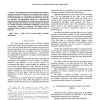Free Online Productivity Tools
i2Speak
i2Symbol
i2OCR
iTex2Img
iWeb2Print
iWeb2Shot
i2Type
iPdf2Split
iPdf2Merge
i2Bopomofo
i2Arabic
i2Style
i2Image
i2PDF
iLatex2Rtf
Sci2ools
101
Voted
WCE
2007
2007
Stochastic Urban Rapid Transit Network Design
— The rapid transit network design problem considers at upper level the list of potential transit corridors and stations to design the network as a discrete space of alternatives. At lower level the alternatives are evaluated based on the route and mode user decisions. The optimization objective is to maximize the transit demand considering the user’s behaviour and the network design constraints. The stochastic extension considers the demand as a random variable, the formulation considering “a priori” and “a posteriori” models are considered. The model is proved experimenting the formulations using Branch and Bound in test networks.
Related Content
| Added | 07 Nov 2010 |
| Updated | 07 Nov 2010 |
| Type | Conference |
| Year | 2007 |
| Where | WCE |
| Authors | Carlos Bouza, Gemayzel Bouza, Ángel Marín |
Comments (0)

